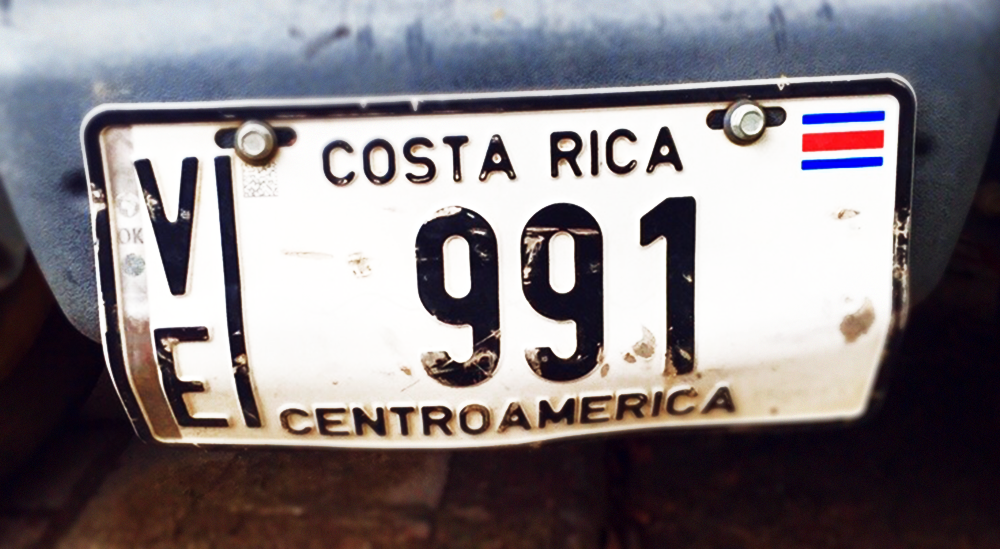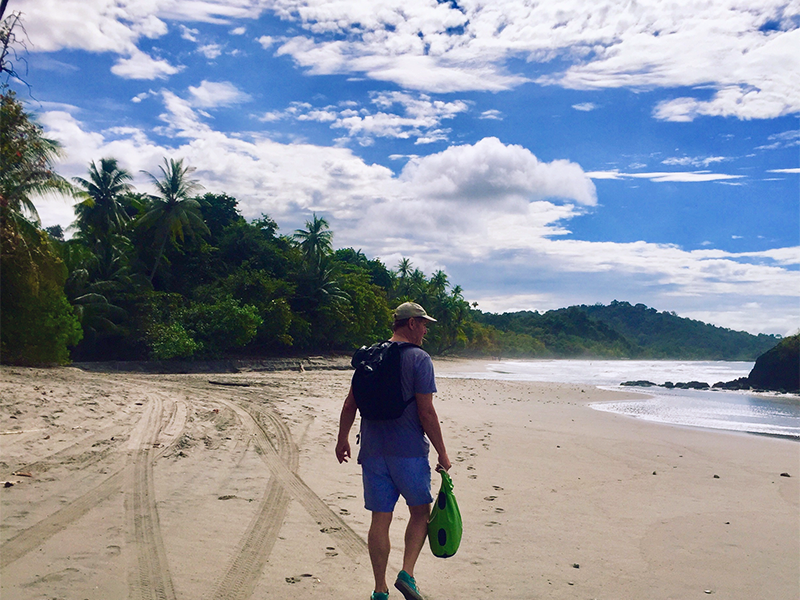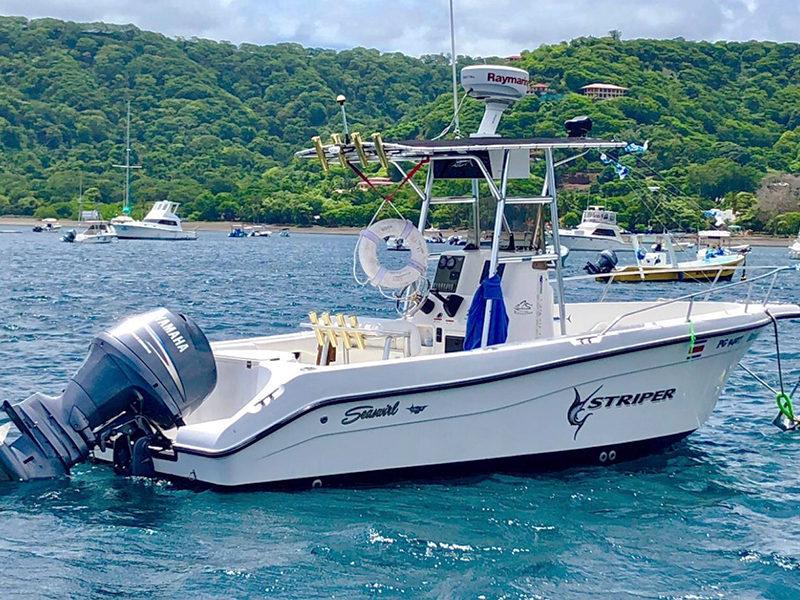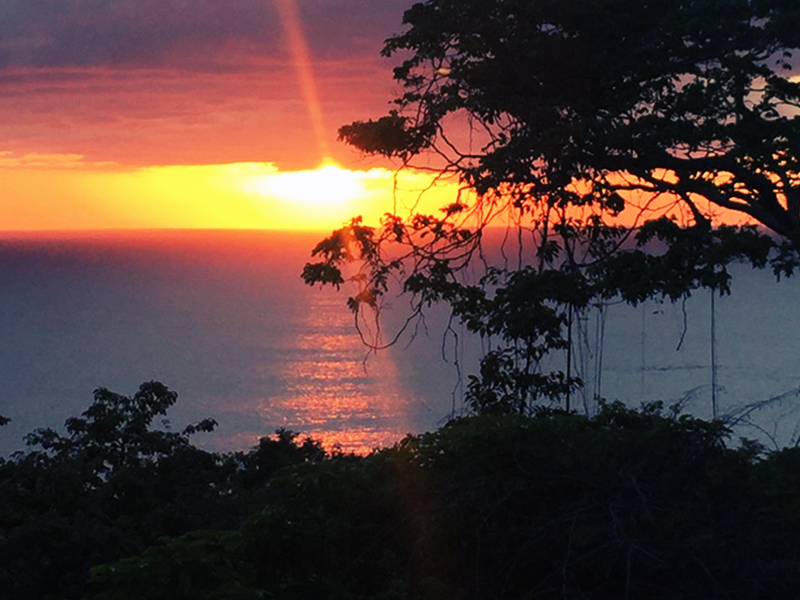“My soul is full of longing for the secret of the sea and the heart of the great ocean sends a thrilling pulse through me.” – Henry Longfellow
I too was mesmerized by the rhythmic natural symphony of the sea, the moon, and the clouds as I arrived late at night at my first place to stay at Arenas Del Mar. In a sentence, the resort has delectable cuisine, exceptional levels of service and exemplary eco credentials. It’s where buggies go up and down the steep slopes and one took me to my tropical fruit breakfast on a table on the sand of Playitas Beach in toe-touching reach of the ocean.
I found an elemental joy in picking up an almond nut from its tree and, as if from heaven, a leaf descends dancing, entertaining and poetically falling while pelicans swooped alongside into the water as all my senses were engaged demonstrating the beauty that nature can provide. Iguanas hang out by the pool, Halloween crabs scuttle through the gardens, sloths slumber in the treetops.
Very close by, down a discreet gravel lane, is a one-of-a-kind Villa Punto de Vista where I was next to stay. This astonishing six-story construction is the courageous and ambitious creation of David Konwiser, one of the family owners and the architect who was born in Costa Rican and educated in America.
The design makes optimum use of the dream views with angular windows jutting out like ships’ prows over the ocean beyond. I looked out over the rocks and islands that speckled the sea like the scales on an iguana’s back, adding perfectly to this ultimate jigsaw picture of a setting. The villa likes to quote “Costa Rica. Lots of Monkeys. No Hurricanes” and it’s fun to get one’s own back on the monkeys by teasing, but not feeding, them with bananas as they approach on their rope through the jungle canopy put up like a zip line in the very country where the sport was invented.
Beside these fast monkeys are slow-moving sloths who feed on ‘cecropia’, liking the alkaline in the high leaves of this hollow tree. They only come down once a week to do their business which they bury to stop predators and to fertilize the tree. They sleep for 18 hours a day and live for 30 to 50 years. And they’re even excellent swimmers I was to learn.
I took a boat with Tres Ninas Tours. It was a full day trip as I got to look up at the houses in the hills and the varieties of the green landscape beyond the beach all competing for light. As the day went on so the light changed affording different hues in the color of the sea from teal to lime green from aquamarine to emerald green. Though Uvita was at high tide when I got there I was intrigued to learn that right above the whale-shaped beach was the favored spot for whales to come and mate.
As for her human inhabitants, Costa Rica is one of the longest-running democracies in Latin America and is safe and peaceful. It’s had no wars for over a hundred years, and there is no standing army. And possessed with this openhearted spirit, some locals are amazed to see guns when they go abroad.
“Pura Vida” is the local expression of their life force. Several countries have an all-purpose word to cover our basic daily forms of interaction. In Hawaii there’s “aloha,” in Fiji there’s “bula’ and in Costa Rica there’s “pura vida.&rsdquo; Literally translating as “pure life” it spans the entire spectrum of greeting and parting incorporating: “no worries,” “enjoy life,” “take it easy” “good luck” and “have a good day.”
I came next further up the Pacific coast to Guanacaste and to the Papagayo peninsula. It’s all beautifully landscaped as a semicircle of large palm trees welcomed me along with a sculpture by Jorge Jiménez Deredia who uses organic shapes that reflect the country’s pre-Columbian heritage. These Diquis stone spheres in particular act as a timeless metaphor of Costa Rica’s deep-rooted egalitarianism: seamless and edgeless and possessing a notion of wholeness.
Papagayo has a number of exquisite beaches. Playa Nacascolo, which was once an area of commerce in pre-Colombian times, is the longest while Playa Jicaro is the most remote on the southern side. In the north, there’s Prieta Beach Club, a perfect day out with its Olas Lounge an ideal spot for lunch in front of waves strong enough for me to body surf.
It is very much an American conceit with its buggies the most common form of transport for visitors. The 18 hole golf course, designed by Arnold Palmer and with Ernie Els as its ambassador, has games played out on ‘paspalum’ the sumptuous carpet-like grass. Near the main entrance, there’s a marina to dock 355 slips where boats for cruising, yachting and sport fishing, particularly for both the black and blue marlin.
I stayed next at Vista Hermosa, Papagayo Luxury. Bang in the middle of the peninsula, this ten-year-old condo is part of the Las Terrazas complex of 16 homes whose owners leave their properties wild around them to grant the animals free movement and whose architect uses terracotta walls both inside and outside to blend in with the natural surroundings and display a contemporary clean aesthetic.
I enjoyed a wonderfully calm boat trip across the bay with Elvision Adventure Tours. My charming and uninvasive skipper guided me with great serenity across the flat water towards the magical beaches of Playa Panama, Playa Hermosa, and the renowned Playa del Coco.
The landscape of Costa Rica and her biodiversity is simply magical: thick lush rainforests, with their dense foliage, uncrowded pristine beaches, steep mountains and majestic volcanoes and waterfalls, the perfect backdrop for the sheer wonder of the colorful birds and animals.
I even looked through the index of the definitive book on Costa Rican birds to find exquisite and exotic names like the chestnut-mandibled toucan, buffy tuftedcheek, long-tailed tyrant, bare-necked umbrellabird, whip-poor-will, double-striped thick-knee, the oilbird, ovenbird and white-fronted nunbird. As for animals, I saw in another book the misfit leaf frog, the bullet ant, the trumpetfish, the beaubrummel (a fish) and the Jesus Christ lizard, so-called as it walks on water.
My final place to stay Four Seasons Resort Costa Rica. The bay side (Playa Blanca) and ocean side (Playa Virador) have a different feel and, I allowed myself to believe, almost a different climate. Eco-friendly electric buggies went at a relaxing speed and it was such an important first scene as the rounded shape of the foyer was truly receptive and embraced me with its open arms, luring me into its golden mosaic fold.
The colors are consistent throughout and blend organically with their natural surroundings. The earth-toned stucco exteriors were computer-generated from actual dirt samples to replicate the deep browns, oranges and reds of the soil and the roots of the land.
How resourceful, cunning and wondrous are the forces of nature: the annona fruit changes from green to a darkish reddish-brown as it ripens, the Indian tree sheds its bark every three days while one local species of grass contracts with human touch. Whales mate above a beach shaped like a whale’s tail. Not to mention all the tricks of camouflage. I have finally learned that sloths are very good swimmers, how hummingbirds manage to stay in mid-air by flapping their wings at a rate of 50 to 80 beats per second and how howler monkeys make so much noise by releasing their voluminous, plangent magic using the wind.
I couldn’t get enough of this delightful country. I have to go back. Whenever but soon.
Adam had further support from www.gatwickexpress.com and www.holidayextras.co.uk (who offer airport lounges at all major UK airports and many international destinations).
All images provided by the author and edited by Barbara Chernyavsky.







